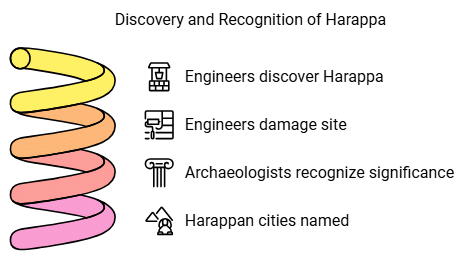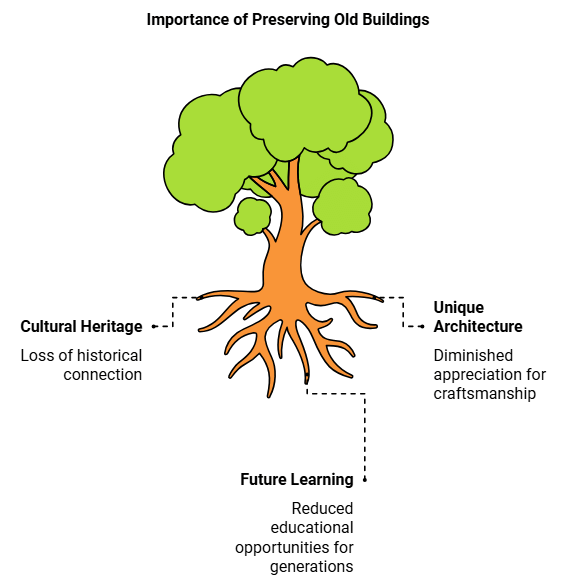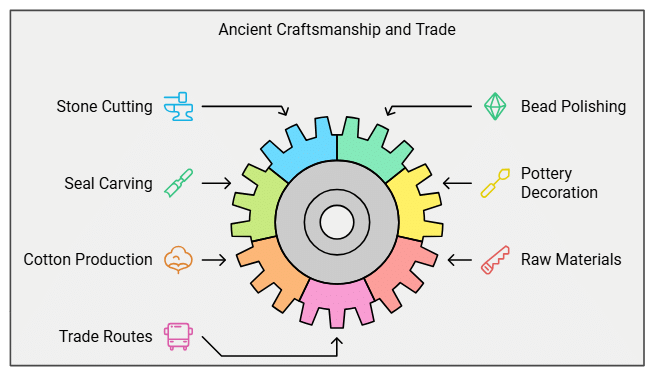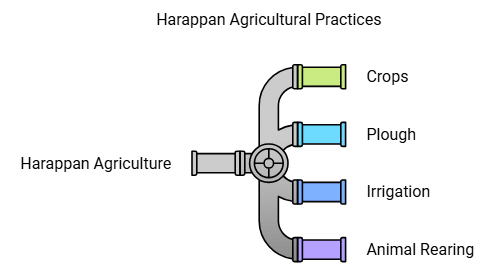Class 6 Exam > Class 6 Notes > Class 6 All Subjects (Old NCERT) > Revision Notes: In the Earliest Cities
Class 6 History Chapter 3 Notes - In the Earliest Cities

The Story of Harappa
- Discovery: About 150 years ago, engineers found Harappa while building railway lines in Punjab (now in Pakistan). They thought it was just a mound and took bricks from the ancient city's walls for construction, causing significant damage.
- Archaeological Significance: Around 80 years ago, archaeologists recognized Harappa as one of the oldest cities in the subcontinent. Since it was the first site discovered, similar sites were called "Harappan." These cities are about 4700 years old.

Importance of Preserving Old Buildings
- Old Buildings: Often, old buildings are demolished to make space for new constructions. The question arises: Is it important to preserve these old structures?
- Preserving old buildings is crucial because they are a link to our cultural and historical heritage. These structures often showcase unique architectural styles and craftsmanship that are rare today. By preserving them, we honour the past, maintain a connection to our history, and ensure that future generations can appreciate and learn from these cultural treasures.
Features of Harappan Cities
- Citadel: The western part was usually smaller but higher and is called the citadel.
- Lower Town: The eastern part was larger but lower, called the lower town.
- Bricks and Walls: The cities were built with well-baked bricks arranged in an interlocking pattern, making the walls strong and durable.
Special Buildings:
- Great Bath in Mohenjodaro: A large tank built with bricks, plaster, and natural tar to make it watertight. It had steps leading down from both sides and rooms around it, possibly used for special occasions.
- Fire Altars: Found in cities like Kalibangan and Lothal, where sacrifices might have been performed.
- Storehouses: Elaborate storage facilities were found in Mohenjodaro, Harappa, and Lothal.
Houses, Drains, and Streets
- Houses: Typically one or two storeys high, built around a courtyard, with separate bathing areas and sometimes wells.
- Drainage System: Cities had well-planned covered drains laid out in straight lines, with a gentle slope to ensure water flow. Drains from houses connected to street drains, with inspection holes for cleaning.
- Urban Planning: The houses, drains, and streets were likely planned and built together.
Life in Harappan Cities
- Rulers: People who likely planned special buildings and controlled trade, sending people to distant lands for metals and precious stones.
- Scribes: Individuals who could write, helping in seal preparation and possibly other documents.
- Craftspersons: Men and women who made various items, either at home or in workshops. They produced tools, ornaments, and terracotta toys.

New Crafts and Materials
Specialists: Crafts were often made by specialists, trained in a specific skill like stone cutting, bead polishing, or seal carving.Materials Used:
- Stone, Shell, and Metal: Used to make tools, weapons, ornaments, and vessels.
- Beads: Made from carnelian, a red stone, cut, shaped, polished, and bored for stringing.
- Seals: Made from stone, often rectangular with animal carvings.
- Pottery: Decorated with black designs.
- Cotton: Grown in Mehrgarh around 7000 years ago; actual cloth pieces were found in Mohenjodaro.
Raw Materials and Trade
- Raw Materials: Substances used to produce goods, some of which were local, while others, like copper, tin, gold, and precious stones, were imported from distant places such as Rajasthan, Afghanistan, Iran, Gujarat, and Karnataka.
- Transport: Goods were transported using various modes, possibly including wheeled vehicles.

Agriculture and Animal Husbandry
- Crops: Harappans grew wheat, barley, pulses, peas, rice, sesame, linseed, and mustard.
- Plough: A tool used for turning soil and planting seeds, likely made of wood.
- Irrigation: Necessary due to low rainfall, involving water storage and distribution.
- Animal Rearing: Cattle, sheep, goats, and buffalo were common, with animals being moved to distant areas during dry seasons.
Harappan Towns in Gujarat
- Dholavira: Located on Khadir Beyt in the Rann of Kutch, divided into three parts with massive stone walls and large open areas for public ceremonies. Unique large letters of the Harappan script were found here.
- Lothal: Situated near the Gulf of Khambat, known for its bead-making workshops, seals, and a dockyard where boats and ships were loaded and unloaded.
Seals and Sealings
Seals were used to stamp goods, ensuring they arrived safely. Sealings were the impressions made on clay.
Decline of Harappan Cities
- Around 3900 Years Ago: Cities saw a decline—people left, writing and seals disappeared, and new settlements emerged.
- Possible Reasons: Rivers drying up, deforestation, flooding, or loss of control by rulers, though none of these reasons fully explain the collapse.

Key Dates
- 7000 years ago: Cotton cultivation at Mehrgarh.
- 4700 years ago: Beginning of Harappan cities.
- 3900 years ago: Start of the decline.
- 2500 years ago: Emergence of new cities.
The document Class 6 History Chapter 3 Notes - In the Earliest Cities is a part of the Class 6 Course Class 6 All Subjects (Old NCERT).
All you need of Class 6 at this link: Class 6
|
297 videos|1065 docs|204 tests
|
FAQs on Class 6 History Chapter 3 Notes - In the Earliest Cities
| 1. What were the main features of the earliest cities? |  |
Ans. The earliest cities typically featured a centralized urban layout, with a distinct administrative center often housing temples or palaces. They had well-defined streets, residential areas, and were surrounded by walls for protection. Additionally, they showed advancements in agriculture, trade, and social organization.
| 2. How did the earliest cities develop economically? |  |
Ans. The economic development of the earliest cities was largely driven by agriculture, which provided surplus food. This surplus allowed for trade with surrounding areas, leading to the establishment of markets. Specialization of labor emerged, with artisans and merchants contributing to the economy, further enhancing trade networks.
| 3. What role did religion play in the earliest cities? |  |
Ans. Religion played a crucial role in the earliest cities, often serving as a unifying force for the community. Temples were central to urban life, facilitating worship and community gatherings. Religious leaders often held significant power, influencing both governance and social structure.
| 4. How did social hierarchies manifest in the earliest cities? |  |
Ans. Social hierarchies in the earliest cities were evident through the division of labor and wealth. Typically, a ruling elite or priest class held power, while farmers, artisans, and laborers occupied lower social strata. This hierarchy was often reflected in housing, with wealthier citizens living in larger, more elaborate homes.
| 5. What were some challenges faced by the earliest cities? |  |
Ans. The earliest cities faced several challenges, including resource management, such as water supply and food production. They also dealt with conflicts over land and resources, social unrest due to inequality, and the need for effective governance to maintain order and provide services to the population.
Related Searches

















